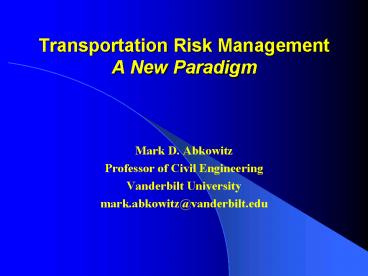Transportation Risk Management A New Paradigm - PowerPoint PPT Presentation
1 / 20
Title:
Transportation Risk Management A New Paradigm
Description:
Man-Made Disasters. floods. earthquakes. tornados. fires. hurricanes. etc. Accidental ... No Impact. Catastrophic Impact. Since 9/11/01. Consequence Measures ... – PowerPoint PPT presentation
Number of Views:399
Avg rating:3.0/5.0
Title: Transportation Risk Management A New Paradigm
1
Transportation Risk ManagementA New Paradigm
- Mark D. Abkowitz
- Professor of Civil Engineering
- Vanderbilt University
- mark.abkowitz_at_vanderbilt.edu
2
Impact of Recent Terrorist Acts
- Security issues have not received enough explicit
risk management attention. - Event outcomes can be far more severe than
previously imagined. - The bar has been raised on risk management best
practice to meet public expectations. - Conclusion a new paradigm is needed to properly
integrate these considerations into traditional
risk management activities.
3
Overarching Observation
- Transportation security traditional risk
management share a common objective - To reduce the likelihood and consequences of
disasters so as to protect human health, quality
of life and the environment - This offers the potential to introduce an
integrated decision-making framework
4
Effect of Shifting Resources From Traditional
Risk Management to Security Initiatives
5
Fundamental Risk Management Questions
6
The Risk Management Spectrum
Natural Disasters
Man-Made Disasters
Accidental
Intentional
- floods
- earthquakes
- tornados
- fires
- hurricanes
- etc.
- biological
- chemical/nuclear
- cyber
- physical attack
7
Re-Visiting Consequence Scenarios
Since 9/11/01
No Impact
Catastrophic Impact
8
Consequence Measures
- Fatalities injuries (acute and long-term)
- Cleanup disposal costs
- Property product damage
- Loss due to business interruption
- Environmental degradation ecosystem damage
- Traffic community disruption
- Public anxiety
- Diminished agency/company value image
9
Re-Visiting Incident Likelihood
Event Likelihood
Since 9/11/01
Consequence
10
Risk Prioritization Process
- Identify critical transportation facilities
- Perform risk assessments
- Develop risk management control strategies
- - prevention deterrence
- - preparedness
- - response
- - recovery
- Implement strategy
- Monitor performance
11
Transportation Vulnerability Points
- Highways
- Pipelines
- Railroads
- Navigable waterways
- Air transport networks
- Fixed facilities (traffic management centers,
terminals, transfer storage sites, rest areas) - Infrastructure hot spots (bridges, tunnels)
- Vehicles that use these facilities
12
Institutional CoordinationTransportation Risk
Managers
Federal Agencies
Local Agencies
State Agencies
Shippers
Travelers
Carriers
Public
13
Institutional Coordination Security Motivators
- Need for timely, accurate and protected
information - Increased scale and type of communication
interfaces to establish and maintain - Managing and deploying greater response resources
to more victims over a larger area
14
Decision-Support Needs
- Plan track before/during/after a major event
- Assess prioritize locations in need of risk
management attention - Identify at-risk populations sensitive
environments - Communicate risks to affected parties
- Locate deploy response resources
- Estimate damage
- Identify evaluate mitigation strategies
- Maintain a centralized risk management
information system
15
Enabling Tools
- Knowledge awareness building
- Process development
- Intelligence gathering
- Emergency response planning
- Information management
16
Information Technologies
- Surveillance detection
- Geographic information systems (GIS)
- Global positioning systems (GPS)
- Communications devices and networks
17
Summary Conclusions
- A new paradigm is needed to accommodate
transportation risks caused by intentional acts - It is based on the concept of integrating
security risk with other transportation risks - A highly-coordinated, broad-based, systematic and
process-oriented approach is fundamental to its
success - Enabling tools, utilizing information technology,
are needed so risk managers can operate with a
high degree of confidence
18
(No Transcript)
19
Panel Participants
- Cherry Burke, Dupont
- Bob Fronczak, Association of American Railroads
- Doug Reeves, U.S. Department of Transportation
- Adam Thiel, Virginia Department of Fire Programs
20
Panel Topics
- What is transportation risk management (TRM)?
- Do you distinguish between safety and security in
addressing TRM considerations? Why or why not? - What significant TRM accomplishments have
occurred since 9/11/01? - What critical TRM challenges lie ahead?
- What is your organization/industry doing to
address these challenges?































